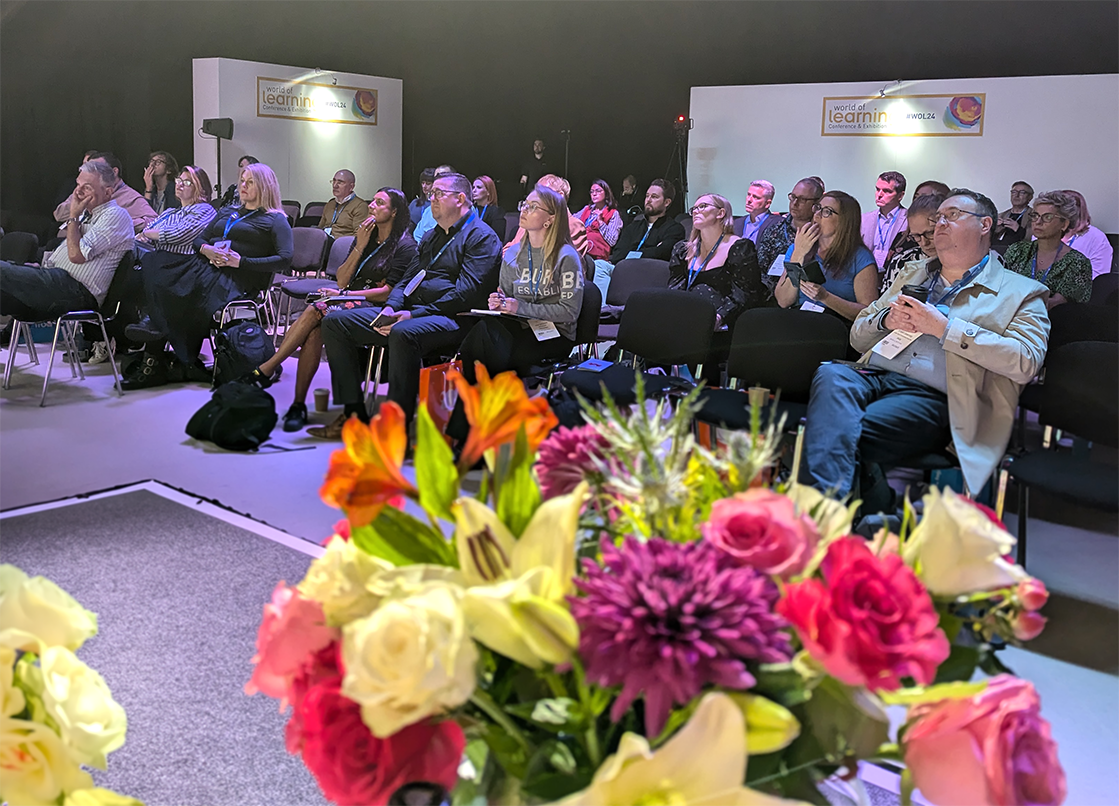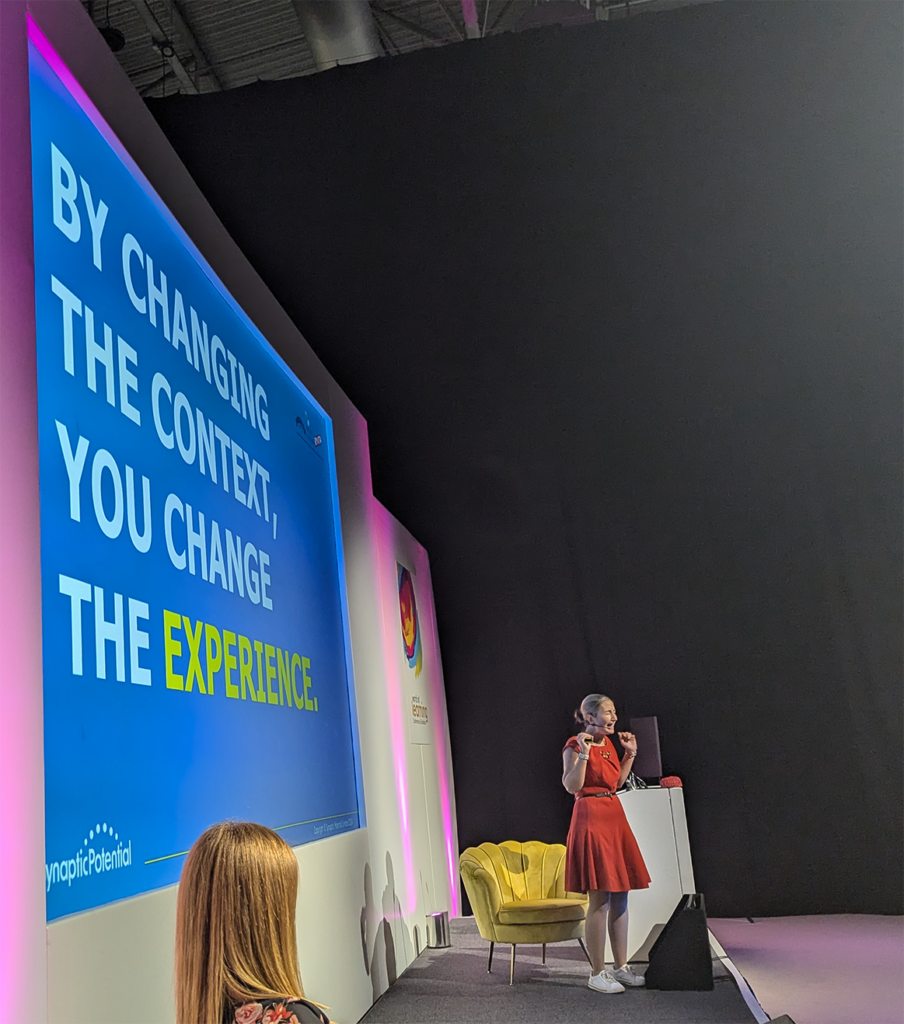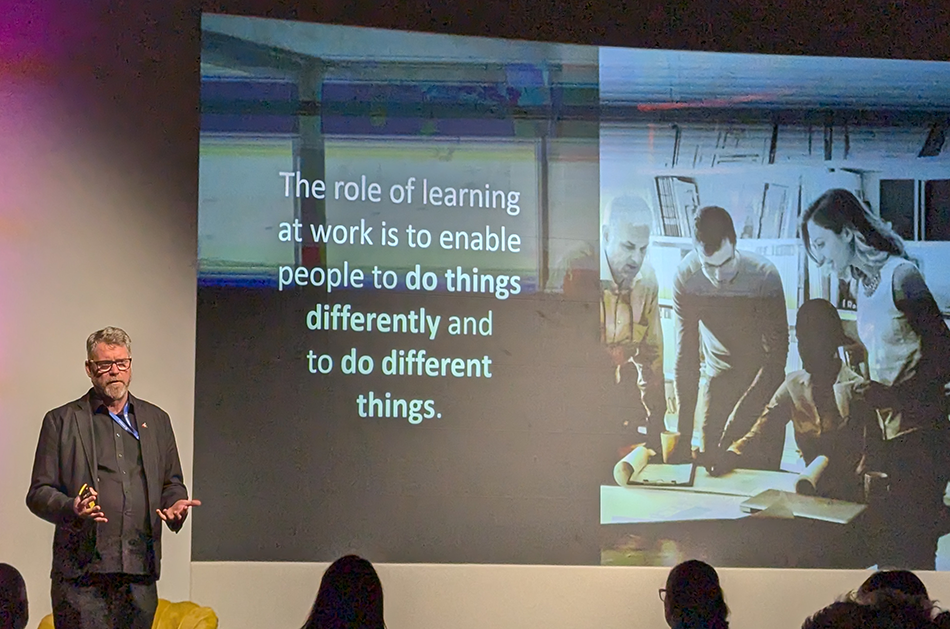Explore key points from the World of Learning conference, including AI, neuroscience, leadership and inclusivity – all summarised by Editor Jo Cook
At the World of Learning conference, industry leaders shared innovative ideas and practical approaches for transforming workplace learning. Below are the key takeaways from sessions that addressed managerial buy-in, leadership in changing environments, neuroscience in learning, AI-driven skill measurement, and workforce planning – all of which took place in Birmingham, UK, in October 2024.
We don’t just train a leader, we create an opportunity to make change
Laura Overton
Empowering managers to support workplace learning
In one of the opening sessions, Sonali Narendran expanded on this by stressing the need for a strong learning ecosystem, which relies on enablers like psychological safety, a growth mindset, a 70:20:10 learning framework and accountability. She also pointed out the increasing complexity of the managerial role, which demands a balance between innovation and maintaining foundational support structures.
Andy Lancaster highlighted the importance of engaging managers to embed learning in the flow of work. Andy emphasised that co-designing learning initiatives with managers, providing them with support packs, and clearly communicating the value of these programmes can significantly boost workplace learning.
A “World Café” approach explored various questions, with suggestions and strategies from participants.
Q: How can we support managers to enhance the learning culture in their context.
Answers included:
- Create engaging and practical learning experiences for managers to demonstrate the value of learning to them – learning marketing
- It has to start at the top and grow out from there
- Recognising the role of managers in building a learning culture, which often isn’t a priority amongst other areas they are assessed on
Q: What tactics can we encourage managers to use to integrate learning in work?
- Use bite size learning, particularly with younger generations
- Create a leadership framework aligned to objectives of line managers
- Maintain the drumbeat around “why” to integrate learning
- Build reflection an ongoing process
- Use story telling
- Reinforce psychological safety to ensure learning through failure is safe
- Facilitate learning moments or discussions during the day and highlight on-the-job learning opportunities
- Encourage peer sharing and coaching
Q: How can we support manager buy-in for learning and what challenges must be overcome?
- Time is a challenge – build clear guidance on how to do it and make it easy
- Build tools/supports that extract as much learning value out of as little time investment as possible
- Co-design to connect to their “why” and support business goals
- Leadership coaching
- L&D should provide context, step-by-step explanations and examples of how others have successfully implement similar solutions
- Managers may need more practical support than we think
- Get alongside them to fully understand their needs and pressures
Leadership in a rapidly changing environment
Laura Overton and Emma Weber led a session focused on helping leaders thrive amid constant change. A live poll revealed that the biggest challenges for leaders are time constraints and being equipped for adaptability.
Laura shared that future key skills come in two parts:
- Data, digital literacy and technical skills
- Social emotional, critical thinking and problem solving
Laura highlighted that learning needs to shift to outcomes: data, change, performance.
“We don’t just train a leader” said Laura about our role in organisational development, “we create an opportunity to make change”.
Both argued that future leadership will demand proficiency in both data literacy and emotional intelligence. Emma noted the importance of leaders maintaining a “centred space” to avoid being overly influenced by external pressures. Leadership development should, therefore, focus on empowering leaders to drive meaningful change within their organisations.
Using neuroscience to enhance learning design
Amy Brann explored how neuroscience can inform better learning experiences by focusing on the brain’s natural processes, such as active learning, retrieval practice, and social interaction. However, she cautioned against rigid instructional design, advocating instead for adaptable learning environments that cater to diverse needs.
Amy also gave an example that following a recipe should give you the same results, but different people around you, the utensils you eat or drink from and much more change the experience – so for learning, by changing the context you change the experience for people.
Laura Grieves-Johnson presented case study findings that demonstrated the power of curiosity, reflection, and leadership engagement in achieving higher performance in a business context.
Creating a learning ecosystem to support change
Kathryn Kenworthy discussed the importance of cultivating curiosity, constructive challenge, and collaboration to support organisational change. She advocated for the 70:20:10 model, which balances experience, exposure, and education. Kathryn shared the how of linking learning to personal goals and role requirements, guiding people in navigating their own learning journey.
Kathryn also emphasised the need for L&D professionals to engage with various parts of the business and be comfortable with ambiguity.
Hayley Brown echoed these sentiments, suggesting that storytelling, backed by data, is an effective tool for creating memorable learning experiences. Hayley has also said that “In L&D we can be a professional noticer” with regards needs and changes in organisations.
Inclusivity and psychological safety in learning
In a session on inclusivity, Pash Reddy underlined the importance of understanding personal biases and preferences to foster an inclusive learning culture. The discussion also touched on initiatives like the “Great Minds Don’t Think Alike” campaign, which focused on hidden disabilities and neurodiversity, promoting a more inclusive environment for all learners.
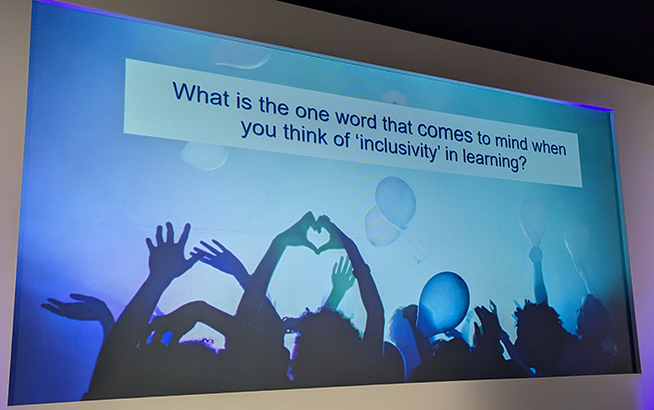
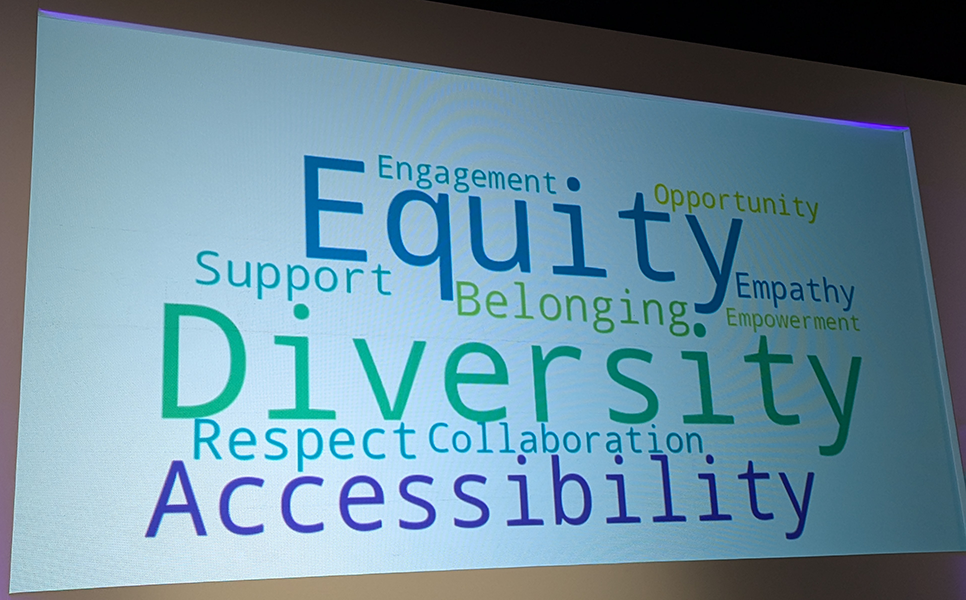
Pash suggested that building a sustainable learning strategy needed continuous learning, adaptability and inclusivity. Different ways to build action inclusive learning included steps such as thinking about diverse learning materials, accessible content and inclusive language. Participants highlighted practical insights, such as avoiding certain words like “click” in digital interfaces to accommodate accessibility needs. Using the word “click” means that a screen reader will actually make that sound rather than read the word. Jayne Davids also highlighted that it’s not inclusive in terms of technology used, such as phones, tables or even laptop touch pads.
Finishing the session, Pash highlighted that working inclusively can bring a 17% increase in team performance, 20% improvement in decision-making quality and 29% boost on collaboration.
AI and its role in scaling learning interventions
L&D has a problem with skills
James Swift
In this session James Swift explored the role of AI in measuring skills adoption within organisations with a case study. James said: “L&D has a problem with skills. It’s not just tagging content, you need to measure peoples skills deployment on the job.” The case study showed that AI was used to analyse customer conversations and link key words to skills, providing valuable insights into skill deployment in real time: rather than the time-consuming observation of client calls, recording of virtual meetings allowed for AI key word analysis that was linked to skills. James wanted to focus on changing the organisation, and therefore questioned “how good are we at changing the human capability?” before emphasising that AI-enabled coaching will be crucial for driving organisational performance.
Erica Farmer started by highlighting that modern L&D includes attracting and retaining talent first of all, then developing skills and capabilities, driving performance and productivity, motivating and engaging, all whilst creating a values based culture and building an employer brand. It’s interesting that Erica made an important point that organisations should make an assumption of a “digital first mindset” so that something like AI isn’t waterfalled to L&D, but that we find use cases to inform and drive our approach. However she was also quick to emphasise the need for a human-centric approach, advising organisations to integrate AI into learning practices while maintaining a strong focus on people’s emotional and cognitive engagement.
Skills-based workforce planning
Kay Collier presented the need for a strategic skills-based approach to workforce planning, especially in long-term industries like nuclear energy, where planning extends over centuries. Meanwhile, Rachel Moore highlighted the challenges of a multi-generational workforce, stressing the need for leaders to prepare for lateral career movement and to address rapid skill obsolescence. Both speakers agreed on the importance of clarity in leadership, especially when planning for future skills needs and Rachel highlighted the importance of building relationships.
The role of learning
Being at a conference focused on the learning community and people profession, it’s always good to revisit the basics, and conference chair Robin Hoyle did that, reminding us that “the role of learning at work is to enable people to do things differently and to do different things”.
Robin asked the audience to consider how organisations strategically solve the issue of new skills – buying in with new hires, external consultants, contractors, partnerships and so on, or growing the skills internally. He highlighted that it’s not an either-or situation and a mixture that’s different for each organisation.
In contrast to the opening about what people do at work, Robin went on to explore a learning journey that started with knowledge and education and ended with a call to action to rouse L&D!
Reflections on psychological safety and the future of learning
Throughout the conference, several themes recurred, particularly the emphasis on psychological safety and reflection in workplace learning. A key element to the discussion of reflection was that it shouldn’t be navel gazing, but a more structured and action-based approach to move teams and organisations forwards.
From neuroscience-based design to AI-driven coaching, the future of L&D seems to be steering towards creating adaptive, inclusive, and data-informed learning ecosystems that not only upskill individuals but also prepare organisations for an ever-changing world.
As L&D professionals, the challenge lies in not just equipping leaders and employees with the right tools but fostering the mindset needed to embrace change and continuous learning.
You can also watch a video summary of the event.
Jo Cook is Editor of Training Journal and a learning specialist at her company Lightbulb Moment

